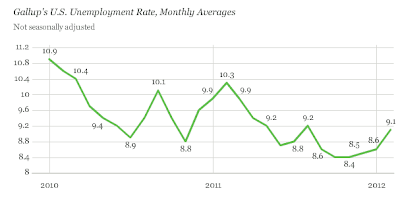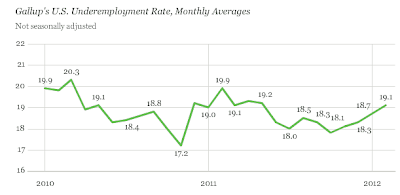Results 1 to 2 of 2
Thread Information
Users Browsing this Thread
There are currently 1 users browsing this thread. (0 members and 1 guests)
-
03-10-2012, 06:15 AM #1Senior Member


- Join Date
- May 2007
- Location
- South West Florida (Behind friendly lines but still in Occupied Territory)
- Posts
- 117,696
Gallup Reports Large Jump in Unemployment to 9.1%, Underemployment to 19.1%
Gallup Reports Large Jump in Unemployment to 9.1%, Underemployment to 19.1%
Thursday, March 08, 2012 2:30 PM
In tomorrow's BLS payroll report, economists forecast an increase of 225,000 private jobs and total non-farm payrolls growth of 210,000. ADP expects 216,000 private jobs. I will take the under.
Meanwhile Gallup reports U.S. Unemployment Up in February
U.S. unemployment, as measured by Gallup without seasonal adjustment, increased to 9.1% in February from 8.6% in January and 8.5% in December.Unemployment Rate Not Seasonally Adjusted
 <-- Click on the Charts to Enlarge
<-- Click on the Charts to Enlarge
The 0.5-percentage-point increase in February compared with January is the largest such month-to-month change Gallup has recorded in its not-seasonally adjusted measure since December 2010, when the rate rose 0.8 points to 9.6% from 8.8% in November. A year ago, Gallup recorded a February increase of 0.4 percentage points, to 10.3% from 9.9% in January 2011.
In addition to the 9.1% of U.S. workers who are unemployed, 10.0% are working part time but want full-time work. This percentage is similar to the 10.1% in January, but is higher than the 9.6% of February 2011.
As a result, Gallup's U.S. underemployment measure, which combines the percentage of workers who are unemployed and the percentage working part time but wanting full-time work, increased to 19.1% in February from 18.7% in January. This is an improvement from the 19.9% of February 2011.
 <-- Click on the Charts to Enlarge
<-- Click on the Charts to Enlarge
Looking Ahead to the Government's Unemployment Report
Last February, the U.S. Bureau of Labor Statistics applied a seasonal adjustment factor of 0.5 points to its unadjusted unemployment rate for the month. If that same seasonal adjustment is applied to Gallup's mid-month unemployment rate of 9.0%, it would produce a seasonally adjusted unemployment rate of 8.5%. Alternatively, if it was applied to Gallup's full-month unemployment rate of 9.1%, it would produce a seasonally adjusted rate of 8.6%. Gallup therefore forecasts an increase in the unemployment rate.
 <-- Click on the Charts to Enlarge
<-- Click on the Charts to Enlarge
Except for the years 2008-2009, and recessions in general, seasonally unadjusted unemployment rate tends to peak in January. Thus it will be interesting to watch Gallup's numbers for the next few months to see if there is a definite change in trend.
Mike "Mish" Shedlock
Mish's Global Economic Trend Analysis
Mish's Global Economic Trend Analysis: Gallup Reports Large Jump in Unemployment to 9.1%, Underemployment to 19.1%Join our efforts to Secure America's Borders and End Illegal Immigration by Joining ALIPAC's E-Mail Alerts network (CLICK HERE)
-
03-10-2012, 06:18 AM #2Senior Member


- Join Date
- May 2007
- Location
- South West Florida (Behind friendly lines but still in Occupied Territory)
- Posts
- 117,696
Nonfarm Payroll +227,000 ; Unemployment Rate Steady 8.3%; BLS vs. Gallup
Friday, March 09, 2012 10:25 AM
Quick Notes About the Unemployment Rate
- In the last year, the civilian population rose by 3,584,000. Yet the labor force only rose by 1,569,000. Those not in the labor force rose by 2,014,000.
- In February, the Civilian Labor Force rose by 476,000.
- In February, those "Not in Labor Force" decreased by 310,000. If you are not in the labor force, you are not counted as unemployed.
- Participation Rate rose .2 to 63.9%
- Were it not for people dropping out of the labor force, the unemployment rate would be well over 11%.
Over the past several years people have dropped out of the labor force at an astounding, almost unbelievable rate, holding the unemployment rate artificially low. Some of this was due to major revisions last month on account of the 2010 census finally factored in. However, most of it is simply economic weakness.
Jobs Report at a Glance
Here is an overview of today's release.
- US Payrolls +227,000 - Establishment Survey
- US Unemployment Rate steady at 8.3% - Household Survey
- Average workweek for all employees on private nonfarm payrolls was unchanged to 34.5 hours
- The average workweek for production and nonsupervisory employees on private nonfarm payrolls edged higher 0.1 hour to 33.8 hours.
- Average hourly earnings for all employees in the private sector rose by 3 cents to $23.31
Recall that the unemployment rate varies in accordance with the Household Survey not the reported headline jobs number, and not in accordance with the weekly claims data.
February 2012 Jobs Report
Please consider the Bureau of Labor Statistics (BLS) February 2012 Employment Report.
Nonfarm payroll employment rose by 227,000 in February, and the unemployment rate was unchanged at 8.3 percent, the U.S. Bureau of Labor Statistics reported today. Employment rose in professional and businesses services, health care and social assistance, leisure and hospitality, manufacturing, and mining.
Unemployment Rate - Seasonally Adjusted

Nonfarm Employment - Payroll Survey - Annual Look - Seasonally Adjusted

Actual employment is about where it was in 2001.
Nonfarm Employment - Payroll Survey - Monthly Look - Seasonally Adjusted

click on chart for sharper image
Between January 2008 and February 2010, the U.S. economy lost 8.8 million jobs.
Over the last two years, nonfarm payrolls have added 3.5 million jobs. Of the 8.8 million net jobs lost between January 2008 and February 2010, 40 percent have been recovered.
Statistically, 127,000 jobs a month is enough to keep the unemployment rate flat. The average employment gain over the last two years has been 145,000, barely enough (statistically speaking) to make a dent in the unemployment rate.
Yet, the civilian unemployment rate has dropped from 9.8% to 8.3%.

Average Weekly Hours

Index of Aggregate Weekly Hours

Average Hourly Earnings vs. CPI

"Success" of QE2 and Operation Twist
- Over the prior 12 months, average hourly earnings have increased by 1.9 percent. In January, the Consumer Price Index for All Urban Consumers (CPI-U) had an over-the-year increase of 2.9 percent; growth in prices has recently been outpacing growth in earnings.
- Not only are wages rising slower than the CPI, there is also a concern as to how those wage gains are distributed.
BLS Birth-Death Model Black Box
The BLS Birth/Death Model is an estimation by the BLS as to how many jobs the economy created that were not picked up in the payroll survey.
The Birth-Death numbers are not seasonally adjusted while the reported headline number is. In the black box the BLS combines the two coming out with a total.
The Birth Death number influences the overall totals, but the math is not as simple as it appears. Moreover, the effect is nowhere near as big as it might logically appear at first glance.
Do not add or subtract the Birth-Death numbers from the reported headline totals. It does not work that way.
Birth/Death assumptions are supposedly made according to estimates of where the BLS thinks we are in the economic cycle. Theory is one thing. Practice is clearly another as noted by numerous recent revisions.
Birth Death Model Adjustments For 2011

Birth Death Model Adjustments For 2012

Birth-Death Note
Once again: Do NOT subtract the Birth-Death number from the reported headline number. That approach is statistically invalid.
Household Survey Data

click on chart for sharper image
In the last year, the civilian population rose by 3,584,000. Yet the labor force only rose by 1,569,000. Those not in the labor force rose by 2,014,000.
That is an amazing "achievement" to say the least, and as noted above most of this is due to economic weakness not census changes.
Decline in Labor Force Factors
- Discouraged workers stop looking for jobs
- People retire because they cannot find jobs
- People go back to school hoping it will improve their chances of getting a job
- People stay in school longer because they cannot find a job
Were it not for people dropping out of the labor force, the unemployment rate would be well over 11%.
Part Time Status

click on chart for sharper image
Part-time status shows little improvement vs. a year ago.
Table A-15

click on chart for sharper image
Table A-15 is where one can find a better approximation of what the unemployment rate really is.
Notice I said "better" approximation not to be confused with "good" approximation.
The official unemployment rate is 8.3%. However, if you start counting all the people that want a job but gave up, all the people with part-time jobs that want a full-time job, all the people who dropped off the unemployment rolls because their unemployment benefits ran out, etc., you get a closer picture of what the unemployment rate is. That number is in the last row labeled U-6.
U-6 is much higher at 14.9%. Both numbers would be way higher still, were it not for millions dropping out of the labor force over the past few years.
Grossly Distorted Statistics
Given the complete distortions of reality with respect to not counting people who allegedly dropped out of the work force, it is easy to misrepresent the headline numbers.
Digging under the surface, the drop in the unemployment rate over the past two years is nothing but a statistical mirage. Things are much worse than the reported numbers indicate.
BLS vs. Gallup
Gallup has the unemployment rate at 9.1% not 8.3% and the "underemployment" number at 19.1%, not 14.9%.
Bear in mind the Gallup numbers are not seasonally adjusted but the BLS numbers reported above are. Nonetheless, it's entirely safe to say that 19.1% is far closer to the truth than 14.9%.
Please see Gallup Reports Large Jump in Unemployment to 9.1%, Underemployment to 19.1% for details.
Mike "Mish" Shedlock
Mish's Global Economic Trend Analysis
Mish's Global Economic Trend Analysis: Nonfarm Payroll +227,000 ; Unemployment Rate Steady 8.3%; BLS vs. Gallup
Join our efforts to Secure America's Borders and End Illegal Immigration by Joining ALIPAC's E-Mail Alerts network (CLICK HERE)


 LinkBack URL
LinkBack URL About LinkBacks
About LinkBacks




 Reply With Quote
Reply With Quote


Report: White House Considers Inviting Gaza Palestinians as...
05-01-2024, 04:27 AM in General Discussion